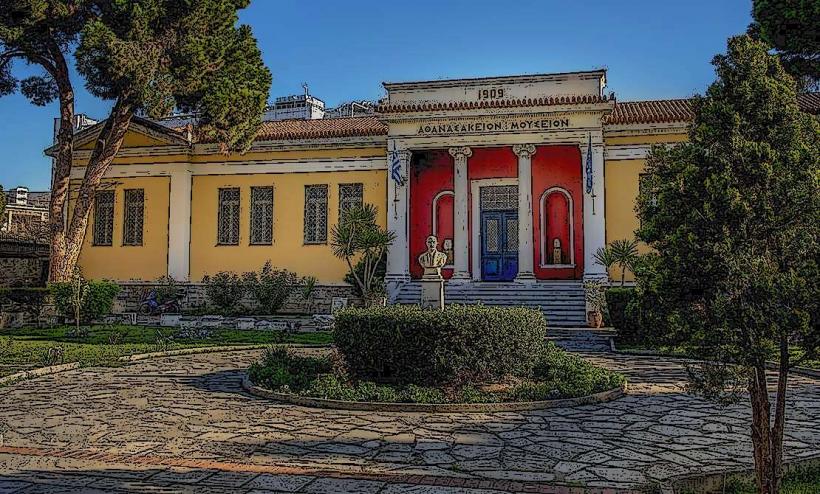Information
Landmark: Archaeological Site of DiminiCity: Volos
Country: Greece
Continent: Europe
The Archaeological Site of Dimini (Greek: Αρχαιολογικός Χώρος Διμήνι) is an important prehistoric settlement located in the Thessaly region of central Greece, near the modern city of Volos. This site is renowned for its well-preserved ruins from the Early and Middle Helladic periods, and it offers valuable insight into the life and culture of the Minoan and Mycenaean civilizations. Dimini is a significant archaeological site, as it provides evidence of early Greek civilization dating back to the 3rd millennium BCE.
1. Historical Background
Early Settlements: The settlement of Dimini dates back to the Late Neolithic and Early Bronze Age, with evidence suggesting that it was occupied continuously for several centuries. The settlement appears to have flourished particularly during the Middle Helladic period (circa 1900-1600 BCE), when it was a major center of regional trade and culture. It is believed that Dimini was a thriving community engaged in agricultural activities, pottery production, and trade with neighboring regions.
Mycenaean Influence: During the Late Bronze Age (circa 1600-1100 BCE), Dimini became a key settlement in the Mycenaean civilization. This period saw the construction of impressive architectural structures, such as large tholos tombs and fortifications. The site of Dimini likely played an important role in the development of Greek culture during this era, connecting the mainland with other areas of the Aegean world.
Decline: Like many ancient settlements, Dimini began to decline towards the end of the Mycenaean period, possibly due to invading forces, natural disasters, or changing trade routes. However, evidence of continued habitation into the Geometric and Archaic periods has been found, indicating that Dimini was not entirely abandoned after the fall of the Mycenaean civilization.
2. Archaeological Significance
The archaeological site of Dimini is particularly important for its prehistoric structures and artifacts, as well as for its role in understanding the transition from the Neolithic to the Bronze Age in Greece.
Tholos Tombs: One of the most notable features of Dimini is the presence of large tholos tombs. These beehive-shaped structures, typically associated with Mycenaean elite burials, are made of carefully arranged stone and are covered by a domed roof. The tombs at Dimini are some of the best-preserved examples in Greece. The tombs suggest the presence of an elite class and may indicate that Dimini was a significant center for Mycenaean cultural and political activities.
Minoan and Mycenaean Architecture: Excavations at Dimini have revealed well-constructed buildings made from stone and mudbrick. Some of these buildings appear to have been communal structures, possibly used for ceremonial purposes, as well as residential buildings for the inhabitants. The presence of frescoes and pottery painted in the distinctive styles of both the Minoan and Mycenaean cultures demonstrates the site's role as a significant cultural hub.
Fortifications: The site features the remains of a defensive wall and gates, indicating that Dimini was a well-protected settlement. These fortifications would have been necessary to protect the community from external threats, especially during the turbulent periods of the Late Bronze Age.
Artifacts: Numerous artifacts have been discovered at Dimini, including pottery, tools, jewelry, and figures made of clay. The pottery found at the site reveals the cultural influences of both the Minoan and Mycenaean civilizations. Many of the artifacts are displayed in the Archaeological Museum of Volos, allowing visitors to explore the material culture of the settlement.
3. Key Discoveries
The Megaron: One of the most important discoveries at Dimini is the Megaron-like structure, a large building that appears to have been a central meeting or gathering place. This structure may have served as the residence of a local ruler or as a ceremonial hall. Its layout is similar to that of the palaces found at other Mycenaean sites, such as Pylos and Mycenae, suggesting that Dimini was part of the broader Mycenaean world.
Frescoes and Pottery: Several frescoes have been uncovered, depicting geometric patterns and scenes from everyday life. These paintings provide insight into the artistic traditions of the time. The pottery from Dimini is similarly significant, with examples of Minoan-style ceramics alongside Mycenaean types, demonstrating the cultural exchanges that occurred between the two civilizations.
Tholos Tombs: The tombs at Dimini, particularly the tholos tomb of Agios Nikolaos, are among the best-preserved examples of this type of burial structure in Greece. These tombs were used to bury the elite members of the community and contain impressive burial offerings, such as vessels, tools, and personal items.
4. Visitor Experience
The Site Layout: Today, the archaeological site of Dimini is an open-air museum where visitors can explore the remains of the ancient settlement, including the tholos tombs, residential buildings, and defensive walls. The site is well-maintained, and informative signs provide historical and cultural context for the structures.
Archaeological Museum of Volos: Many of the artifacts uncovered at Dimini are displayed at the nearby Archaeological Museum of Volos, which offers a deeper understanding of the site’s history and its role in the development of Bronze Age Greece. The museum features pottery, tools, jewelry, and other finds that help to illustrate the daily life, religion, and trade of the people who lived at Dimini.
Scenic Location: Dimini is located just outside the city of Volos, with beautiful views of the surrounding landscape, including the nearby Pagasetic Gulf. The location adds to the experience, as visitors can appreciate the strategic importance of the site within the context of the surrounding geography.
5. Cultural and Historical Importance
Transition from Neolithic to Bronze Age: Dimini provides crucial evidence for understanding the transition from the Neolithic to the Bronze Age in Greece. The site shows how early agricultural communities began to evolve into more complex, urbanized societies with specialized production, trade, and elite classes. It also provides insight into the spread of Minoan cultural influences into the mainland.
Mycenaean Influence: Dimini is part of the broader network of Mycenaean centers that dominated the Greek mainland during the Late Bronze Age. Its architectural and artistic features show how the Mycenaeans developed and adapted cultural practices from the Minoans on Crete and other Aegean islands.
Regional Trade and Contacts: The discovery of a wide range of artifacts from other regions of the Aegean world suggests that Dimini was involved in a wide-reaching trade network. The settlement likely exchanged goods with other important centers in the Aegean, including the Minoan and Mycenaean cities.
Conclusion
The Archaeological Site of Dimini is a remarkable prehistoric settlement that offers a window into the early Bronze Age and the development of Greek civilization. With its well-preserved tholos tombs, Minoan and Mycenaean architecture, and a rich array of artifacts, Dimini provides valuable insights into the life of the early Greeks and their cultural interactions with neighboring civilizations. Today, it remains an important site for both scholars and visitors interested in exploring the origins of Greek culture and the Bronze Age world.



